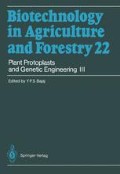Abstract
Lisianthus (Eustoma grandiflorum (Griseb) Shinn.] is a gentian native to the central and southern United States (Bailey 1949, Shinners 1957). Due to its large flowers, long stems, and extended vase life, it is an increasingly popular cut flower. The typical wild plant has blue-purple flowers, but intensive breeding in Japan over the last 30 years has produced varieties with white, pink, plum, and mauve flowers. To enhance the popularity of lisianthus, new varieties need to be developed. Desirable traits include; an expansion of the color range to red and yellow, sectoring of the pigmentation to produce stripes and star patterns, and a more compact plant form for the pot plant market.
Dr. Nigel Given died in June 1991. The authors would like to record their appreciation for the advice and support given by Dr. Given during the course of the work reported
Access this chapter
Tax calculation will be finalised at checkout
Purchases are for personal use only
Preview
Unable to display preview. Download preview PDF.
References
An G, Ebert PR, Mitra A, Ha SB (1988) Binary vectors. In: Gelvin SB, Schilperoort RA (eds) Plant molecular biology manual. Kluwer, Dordrecht, pp A3 1-19.
Asen S, Griesbach RJ, Norris KH, Leonhardt BA (1986) Flavonoids from Eustoma grandiflorum petals. Phytochemistry 25:2509–2513.
Bailey L (1949) Manual of cultivated plants. Macmillan, New York.
Brouillard R (1988) Flavonoids and flower colour. In: Harborne JB (ed) The flavonoids: advances in research since 1980. Chapman and Hall, London, pp 525–538.
Chilton M-D, Farrand SK, Levin R, Nester EW (1976) RP4 promotion of transfer of a large Agrobacterium plasmid which confers virulence. Genetics 83:609–618.
Deroles SC, Gardner RC (1988) Analysis of the T-DNA structure in a large number of transgenic petunias generated by Agrobacterium-mediated transformation. Plant Mol Biol 11:365–377.
Frohman MA, Dush MK, Martin GR (1988) Rapid production of full length cDNA’s from rare transcripts: amplification using a single gene-specific oligonucleotide primer. Proc Natl Acad Sci USA 85:8998–9002.
Garfinkel DJ, Nester EW (1980) Agrobacterium tumefaciens mutants affected in crown gall tumorigenesis and octopine catabolism. J Bacteriol 144:732–743.
Griesbach RJ, Semeniuk P (1987) Use of somaclonal variation in the improvement of Eustoma grandiflorum. J. Hered 78:114–116.
Heller W, Forkmann G (1988) Biosynthesis. In: Harborne JB (ed) The flavonoids: advances in research since 1980. Chapman and Hall, London, pp 399–426.
Hoekema A, Hirsch PR, Hooykaas PJJ, Schilperoort RA (1983) A binary vector strategy based on the separation of the vir and T-DNA regions of the Agrobacterium tumefaciens Ti-plasmid. Nature 303:179–181.
Horsch RB, Fry JE, Hoffmann NL, Eicholtz D, Rogers SG, Fraley RG (1985) A simple and general method for transferring genes into plants. Science 227:1229–1231.
Jansen B, Gardner RC (1990) Localised transient expression of GUS in leaf discs following cocultivation with Agrobacterium. Plant Mol Biol 14:61–72.
Jefferson RA (1987) Assaying chimeric genes in plants: the GUS gene fusion system. Plant Mol Biol Rep 5:387–405.
Ledger SE, Deroles SC, Given NK (1991) Regeneration and Agrobacterium-mediated transformation of chrysanthemum. Plant Cell Rep 10:195–199.
Ledger SE, Deroles SC, Given NK Agrobacterium-mediated transformation of lisianthus (Eustoma grandiflorum) (in prep.).
Linsmaier EM, Skoog F (1965) Organic growth factor requirements of tobacco tissue culture. Physiol Plant 18:100–127.
Martin C, Carpenter R, Coen ES, Gerats AGM (1987) The control of floral.pigmentation in Antirrhinum majus. In: Thomas H, Grierson D (eds) Developmental mutants in higher plants. Cambridge University Press, pp 19-52.
Martin C, Prescott A, Mackay S, Bartlett J, Vrijlandt E (1991) Control of anthocyanin biosynthesis in flowers of Antirrhinum majus. Plant J 1:37–49.
Mol JNM, Stuitje AR, van der Krol A (1989) Genetic manipulation of floral pigmentation genes. Plant Mol Biol 13:287–294.
Murashige T, Skoog F (1962) A revised medium for rapid growth and bioassays with tabacco tissue cultures. Physiol Plant 15:473–497.
Seelye JF, Butcher SM (1987) Micropropagation of lisianthus (Eustoma grandiflorum). Selections IAPTC Book of Abstracts August 1987 Maroochydore, Queensland, Australia.
Semeniuk P, Griesbach RJ (1987) In vitro propagation of prairie gentian. Plant Cell Tissue Organ Cult 8:249–253.
Shinners LH (1957) Synopsis of the genus Eustoma (Gentianaceae). Southwest Nat 2:38–43.
Skrzypczak L, Wesolowska M (1993) Eustoma grandiflorum Shinn (Texas Bluebell): Callus culture, micropropagation, and the production of gentiopicroside and other secondary metabolites. In: Bajaj YPS (ed) Biotechnology in agriculture and forestry, vol 24. Medicinal and aromatic plants V. Springer, Berlin Heidelberg pp 192–201.
van der Krol AR, Lenting PE, Veenstra J, van der Meer IM, Koes RE, Gerats AGM, Mol JNM, Stuije AR (1988) An antisense chalcone synthase gene in transgenic plants inhibits flower pigmentation. Nature 333:866–869.
Author information
Authors and Affiliations
Editor information
Editors and Affiliations
Rights and permissions
Copyright information
© 1993 Springer-Verlag Berlin Heidelberg
About this chapter
Cite this chapter
Deroles, S.C., Ledger, S.E., Miller, R.M., Davies, K.M., Given, N.K. (1993). Transformation in Eustoma grandiflorum (Lisianthus). In: Bajaj, Y.P.S. (eds) Plant Protoplasts and Genetic Engineering III. Biotechnology in Agriculture and Forestry, vol 22. Springer, Berlin, Heidelberg. https://doi.org/10.1007/978-3-642-78006-6_18
Download citation
DOI: https://doi.org/10.1007/978-3-642-78006-6_18
Publisher Name: Springer, Berlin, Heidelberg
Print ISBN: 978-3-642-78008-0
Online ISBN: 978-3-642-78006-6
eBook Packages: Springer Book Archive

